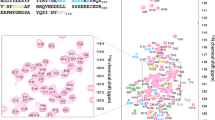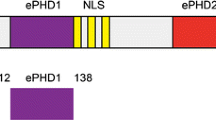Abstract
Engrailed 2 is a transcription factor belonging to the class of homeoproteins. These proteins possess a 60-residue DNA binding globular domain and play an important role in the early stages of development. We expressed and purified a 13.4 kDa fragment of Engrailed 2, which comprises a 54-residue N-terminal extension in addition to the homeodomain region. Almost all backbone and side-chain resonances have been assigned. The weak dispersion in the proton dimension of the 1H–15N HSQC spectrum indicates the presence of disordered regions that do not belong to the homeodomain. This work is a first step toward the NMR investigation of the structure and dynamics of Engrailed 2 protein that contains a well-structured globular domain and partially disordered regions.

Similar content being viewed by others
References
Alberi L, Sgado P, Simon HH (2004) Engrailed genes are cell-autonomously required to prevent apoptosis in mesencephalic dopaminergic neurons. Development 131:3229–3236
Delaglio F, Grzesiek S, Vuister GW, Zhu G, Pfeifer J, Bax A (1995) NMRPipe: a multidimensional spectral processing system based on UNIX pipes. J Biomol NMR 6:277–293
Foucher I, Montesinos ML, Volovitch M, Prochiantz A, Trembleau A (2003) Joint regulation of the MAP1B promoter by HNF3beta/Foxa2 and Engrailed is the result of a highly conserved mechanism for direct interaction of homeoproteins and Fox transcription factors. Development 130:1867–1876
Fraenkel E, Rould MA, Chambers KA, Pabo CO (1998) Engrailed homeodomain-DNA complex at 2.2 Å resolution: a detailed view of the interface and comparison with other engrailed structures. J Mol Biol 284:351–361
Gehring WJ (1987) Homeo boxes in the study of development. Science 236:1245–1252
Gehring WJ, Affolter M, Buerglin T (1994) Homeodomain proteins. Ann Rev Biochem 63:487–526
Joyner AL (1996) Engrailed, Wnt and Pax genes regulate midbrain-hindbrain development. Trends Genet 12:15–20
Kazimierczuk K, Zawadzka A, Kozminski W (2009) Narrow peaks and high dimensionalities: exploiting the advantages of random sampling. J Magn Reson 197:210–228
Maizel A, Tassetto M, Filhol O, Cochet C, Prochiantz A, Joliot A (2002) Engrailed homeoprotein secretion is a regulated process. Development 129:3545–3553
Marley J, Lu M, Bracken C (2001) A method for efficient isotopic labelling of recombinant proteins. J Biomol NMR 20:71–75
McGinnis W, Levine MS, Hafen E, Kuroiwa A, Gehring WJ (1984) A conserved DNA sequence in homeotic genes of the Drosophila Antennapedia and bithorax complex. Nature 308:428–433
Piper DE, Batchelor AH, Chang CP, Cleary ML, Wolberger C (1999) Structure of the HoxB1-Pbx1 heterodimer bound to DNA: role of the hexapeptide and the fourth homeodomain helix in complex formation. Cell 96:587–597
Sattler M, Schleucher J, Griesinger C (1999) Heteronuclear multidimensional NMR experiments for the structure determination of proteins in solution employing pulsed field gradients. Prog Nucl Magn Reson Spectrosc 34:93–158
Simon HH, Saueressig H, Wurst W, Goulding MD, O’Leary DD (2001) Fate of midbrain dopaminergic neurons controlled by the engrailed genes. J Neurosci 21:3126–3134
Sonnier L, Le Pen G, Hartmann A, Bizot JC, Trovero F, Krebs MO, Prochiantz A (2007) Progressive loss of dopaminergic neurons in the ventral midbrain of adult mice heterozygote for Engrailed1. J Neurosci 27:1063–1071
Vranken WF, Boucher W, Stevens TJ et al (2005) The CCPN data model for NMR spectroscopy: development of a software pipeline. Proteins 59:687–696
Acknowledgments
Financial support by the Access to Research Infrastructures activity of the 7th Framework Programme of the EU (Contract 228461, EAST-NMR) for conducting research in Warsaw is gratefully acknowledged. Wiktor Kozminski and Jan Stanek (Department of Chemistry, University of Warsaw) are deeply acknowledged for their help in NMR data collection and fruitful discussions. We thank Alain Prochiantz (UMR 7233 CNRS, Collège de France) for kindly providing the expression plasmid.
Author information
Authors and Affiliations
Corresponding author
Rights and permissions
About this article
Cite this article
Augustyniak, R., Balayssac, S., Ferrage, F. et al. 1H, 13C and 15N resonance assignment of a 114-residue fragment of Engrailed 2 homeoprotein, a partially disordered protein. Biomol NMR Assign 5, 229–231 (2011). https://doi.org/10.1007/s12104-011-9306-5
Received:
Accepted:
Published:
Issue Date:
DOI: https://doi.org/10.1007/s12104-011-9306-5




